#jewish currents
Explore tagged Tumblr posts
Text
“The settlers come wearing soldiers’ clothes, which is a new strategy.”
Since the war started, there have been more and more daily attacks by settlers against the people living in Masafer Yatta [a region of rural hamlets in the south of the occupied West Bank]. We are just farmers, many of us living in caves and tents. I am 18 years old, and I have lived here all my life. We have no way to defend ourselves from the settlers, who are fully armed thanks to [National Security Minister Itamar] Ben-Gvir. They feel that now is their chance. The war is happening, and they have the green light to kill any Palestinian they see. They feel that no one is going to care about these people in Masafer Yatta. They come with the army’s protection from the settlement of Havat Ma’on, just five minutes from my village of Tuwani. They attack people’s sheep and demolish their tents and raid their homes. They attacked my family in our house: They came in and shot at my dad. Luckily he survived, but they broke his hand by hitting him with the butt of a gun. On Friday, they shot my cousin, who is still in the hospital. The settlers come wearing soldiers’ clothes, which is a new strategy; my dad only recognized them as settlers because they were the same people who attacked him last year. The settlers and the army are now controlling all the land around Tuwani. They planted an Israeli flag in the high mountains nearby, and they have blocked all the routes in and out of the area. They don’t even allow us to access our donkeys, or to give them food or water. They’re saying this is state land and it’s a war. It’s dangerous to leave the town. Some people are trying to travel through the mountains, because they need to reach hospitals, or to reach markets to get food and water. But the way through the mountains is bumpy, and they get shot at. No one can sleep at night; we are afraid that the settlers will come and burn down our homes. [x]
— Luna (pseudonym), as told to Amos; Tuwani; October 17th
831 notes
·
View notes
Text
The data on anti-Hindu hate crimes undermine the contention that bigotry against Hindus is on the rise. In a recent article, HfHR co-founder Raju Rajagopal points out that of the 35 groups included in the FBI’s hate crimes database, Hindus were less likely to experience hatred than all but Jehovah’s Witnesses. “Muslims are eight times more likely [to experience hate than Hindus are], Jews are 12 times more likely and Sikhs are 128 times,” Rajagopal wrote. (The HAF see this as evidence of underreporting, which they hope to solve by working with law enforcement and “empowering the Hindu American community to recognize, confront, and report Hinduphobia,” Shukla told Jewish Currents.) HfHR notes on its website that though “Hindus globally face varying levels of discrimination,” the data categorically do not support “the notion of systemic Hinduphobia in the United States.” Truschke agreed that the very concept of Hinduphobia seemed “designed to take individual cases and assert a structural problem.” The goal, Sippy argued, is to “cultivate a narrative of Hindu victimization that is robust enough to justify contemporary atrocities.”
Aparna Gopalan, ‘The Hindu nationalists using the pro-Israel playbook’, Jewish Currents
#Jewish Currents#Aparna Gopalan#Raju Rajagopal#Hindus for Human Rights#FBI#hate crimes#Hinduphobia#United States#Audrey Truschke#Shana Sippy
148 notes
·
View notes
Text
Tl;dr: the writers and editors of Jewish Currents are communists who need to re-read Marx, who don’t and don’t want to deal with the politics of Israel and Palestine
2 notes
·
View notes
Text
I just saw a post on my dash that was uncritical of the ADL, so I'm posting this again
7 notes
·
View notes
Text
CAPTIVITY IS A CONSTITUTIVE PART of Palestinian life under occupation. Prior to Hamas’s attack on October 7th, Israel incarcerated more than 5,200 Palestinians—most of them residents of the West Bank and East Jerusalem—across two dozen prisons and detention centers. Some West Bank residents are incarcerated due to a still-operant military order issued following the 1967 War that effectively criminalized civic activities (e.g. gatherings of more than ten people without a permit, distributing political materials, displaying flags) as “incitement and hostile propaganda actions.” There are currently hundreds of such military orders, which criminalize anything that might be construed as resistance to the occupation. This surfeit of activities made illegal for Palestinians authorizes mass imprisonment: According to a recent estimate by the United Nations, one million Palestinians have at one time been incarcerated by Israel, “including tens of thousands of children.” One in five Palestinians, and two in five Palestinian men, have been arrested at some point in their lives, and, as of 2021, more than 100 Palestinian children faced up to 20 years in prison for throwing stones. Not all who are arrested face charges. Israel often and increasingly makes use of “administrative detention,” a relic of the British Mandate era, which allows for indefinite incarceration without a charge or trial, ostensibly for the purpose of gathering evidence. It was a hallmark of apartheid South Africa and has been used to repress opposition in Egypt, England, India, the United States, and elsewhere, especially in the context of anti-immigration and “counter-terrorism” programs. “Since March 2002, not a single month has gone by without Israel holding at least 100 Palestinians in administrative detention,” the Israeli human rights organization B’Tselem notes; often the number is much higher. Prior to October 7th, more than 20% of Palestinian prisoners were administrative detainees; 233 of the 300 Palestinians on Israel’s release list negotiated last week were administrative detainees, Al Jazeera noted. According to the Palestinian prisoner organization Addameer, imprisoned Palestinians report being beaten, threatened, strip searched, and denied healthcare and contact with their families. Palestinians currently incarcerated, as well as those freed in recent days, report that conditions have worsened since October 7th. Meanwhile, even as this prisoner release proceeds, Israel continues to ramp up arrests: As of Tuesday, 180 Palestinian prisoners have been released as part of the ceasefire exchange, but during the same period, it arrested Palestinians at nearly the same rate. Today, more than 7,000 Palestinians are incarcerated in Israeli prisons. Nowhere is Israel’s carceral regime clearer than in Gaza, the 140-square-mile area often described as an “open-air prison.” Gaza’s residents, now an estimated 2.2 million people—80% of whom are refugees or descendents of refugees forced to flee in the mass expulsions surrounding the founding of the State of Israel that Palestinians call the Nakba—have been hemmed in by a land, air, and sea blockade since 2006. As with Palestinians incarcerated in Israeli prisons, who for years have waged hunger strikes, protested, and written about the horrors of incarceration, Gazans have struggled mightily against their confinement. In 2018–19, they held weekly nonviolent protests at the border under the name Great March of Return. Israel responded with brutal violence, killing 260 people and wounding 20,000 others, many of whom were permanently disabled. A week into Israel’s current assault on Gaza, Ahmed Abu Artema, one of the co-founders of the Great March of Return, wrote an impassioned plea in The Nation, calling for the world to “help us tear down the wall, end our imprisonment, and fulfill our dreams of liberation.” On October 24th, an Israeli airstrike severely wounded Artema and killed five members of his family, including his 13-year-old son.
The Abolitionist Logic of “Everyone for Everyone” A call from the families of hostages contains the seed of true safety. Dan Berger December 1, 2023
2 notes
·
View notes
Text
#palestine#free palestine#labor#jewish currents#i dont necessarily think this is a viable solution to this paradox#but interesting and succinct history of this issue
2 notes
·
View notes
Text
My dear Israeli journalist friend, Amira, is one of the few people who has my absolute R-E-S-P-E-C-T!
“Amira Hass Is Still Angry” from @Jewish Currents
6 notes
·
View notes
Text
On October 11th, four days after Hamas’s attack and Israel’s declaration of war, thousands of Gazan workers logged on to the blue-and-white-colored defense ministry app Al Munaseq (“the coordinator”) to find that Israeli authorities had revoked their work permits, stripping them of their legal status. The change meant that these workers could no longer remain in Israel, but they also could not return home to Gaza, which Israel had placed under a hermetic siege and constant bombardment. “Our situation is very difficult right now,” Saleh, a Gazan who usually works in Jaffa, told Jewish Currents, using a pseudonym for fear of further retaliation. The permit revocation was ordered by the Coordinator of Government Activity in the Territories (COGAT), the Israeli body in charge of Palestinian civilian affairs, and came without any explanation or instruction. And just hours after the permits were revoked, Israeli authorities began detaining the now-illegal workers. By October 17th, 4,000 workers had been detained without trial to check if they “helped Hamas in planning the massacre, ” according to Israel’s Channel 12. Jessica Montell, the executive director of Israeli human rights organization HaMoked, told Jewish Currents that the arrest campaign is “unprecedented in both scope and lack of transparency,” noting that “overnight, thousands of people who had Israeli work permits became illegal aliens and have been rounded up.” Each of these moves is illegal under international law and a “prohibited act of vengeance against the workers,” according to a letter five Israeli human rights organizations sent to Israel’s defense minister, attorney general, and head of COGAT on October 12th. [x]
- jonathan shamir for jewish currents on october 19, 2023
268 notes
·
View notes
Text
Anti-Hindutva groups like HfHR, Sadhana, and Students Against Hindutva Ideology are experimenting with reclaiming Hinduism itself from the Hindu right. HfHR hosts events that reinterpret Hindu tradition through a liberationist lens, such as “Holi against Hindutva,” a gathering that transformed the Hindu “festival of colors” into a day of political education. The group has also retrieved an expansive pantheon of Hindu deities traditionally patronized by queer communities, Dalits, women, and others excluded by the Hindutva project. HfHR has even reinterpreted the idea of Ram rajya, or Ram’s kingdom—a mythological time of divine justice, which the Hindu right has long used to denote the coming of a purely Hindu India—to symbolize something similar to Martin Luther King Jr.’s “beloved community,” a vision of a just, anti-racist society. Hindutva organizations may have positioned themselves as the representatives of the US Hindu diaspora, but Mandalaparthy said that groups like HfHR are contesting for space: “We have intentionally tried to go wherever the Hindu right groups are, so that there’s not just one Hindu voice.”
Aparna Gopalan, ‘The Hindu nationalists using the pro-Israel playbook’, Jewish Currents
#Jewish Currents#Aparna Gopalan#Hindus for Human Rights#Sadhana#Students Against Hindutva Ideology#Hindutva#Nikhil Mandalaparthy
12 notes
·
View notes
Note
I haven’t read the Jewish Currents article about how the Iron Dome isn’t a defensive system (nor do I plan to) but I did read a Twitter thread by JC’s editor in chief defending/explaining the article. Apparently the gist is that as the Iron Dome renders the conflict relatively costless for Israel, they have no serious incentive to come to the negotiating table to end the conflict, and I would actually agree with that statement.
However, the next part is that antizionists should therefore lobby against the US funding the Iron Dome so as to make “costs” more equal, therefore bringing Israel to the negotiating table faster and saving lives in the long run. Aside from that being a fundamentally ghoulish argument (the word “costs” is doing a LOT there), I’m not sure if history of how Israel reacts to threats to its people would bear this thesis out. If the Iron Dome could no longer function, I would suspect that the IDF would glass Gaza before Israel would come to the negotiating table.
I read the same thread, and yes, it was Jewish Currents - already established as quite comfortable with physical violence against Jews - going full 6MWE. They cheer at funerals as happily as Westboro Baptist, just now with a bagel tray. "The mass killings and brutality are ultimately humane, as it will lead to surrender and peace" is literally what ISIS always said about itself.
And yes, what these antizionist shitlords have never understood is that nobody is allowed to kill Jews, for any cause or purpose. Israel will defend itself by any means. Hoping for more Jewish deaths in a way that would provoke more desperate retaliation and more Palestinian deaths is probably a big hit on the email list of their Brooklyn vegan co-op. White leftists want to keep fighting to the last dead Arab.
27 notes
·
View notes
Text
1 note
·
View note
Text
As Israel’s genocidal assault on Gaza enters its 11th day, communication between the besieged enclave and the outside world is quickly becoming impossible. “Given the scale of Israel’s assault—which U.N. experts have warned amounts to ‘collective punishment’ in violation of international law—journalists are facing unprecedented challenges in obtaining and sharing information,” The Washington Post reported on October 16th. These obstacles are reflected in the three dispatches from Gaza collected here. The first, which was written when Israel had just announced it would cut off water and electricity to the Strip, was sent to us via email on October 9th, accompanied by instructions for how to proceed “in case I am unable to reply because we are out of electricity, or because I am martyred.” One week later, written communication was no longer feasible, and the latter two dispatches came in as strings of WhatsApp voice messages on October 16th.
6 notes
·
View notes
Text
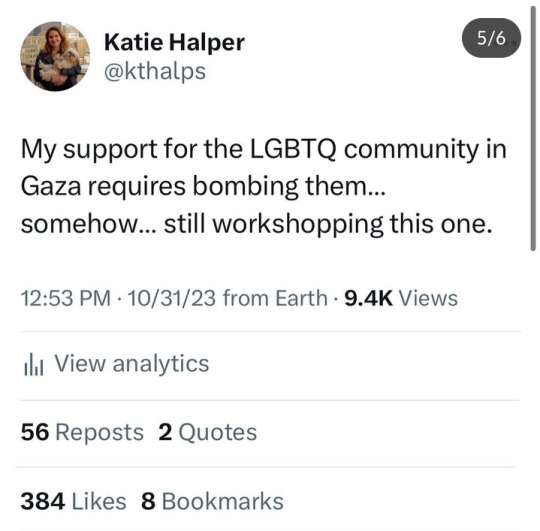

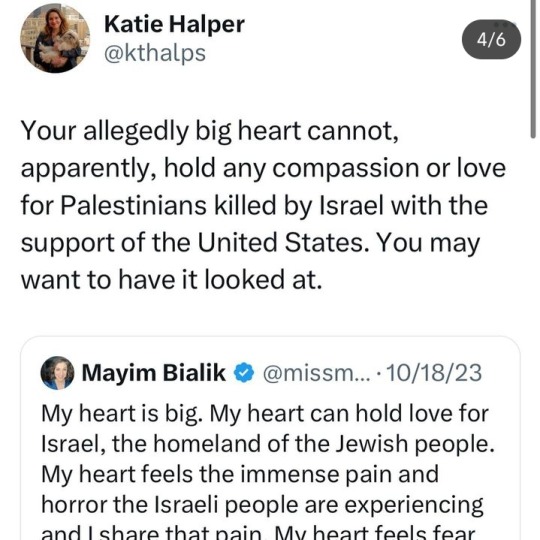
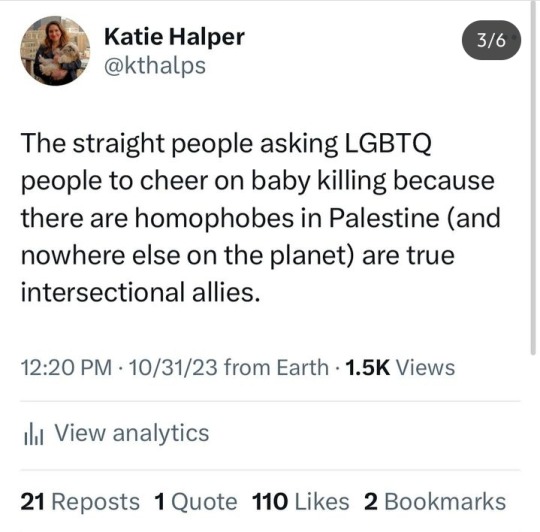
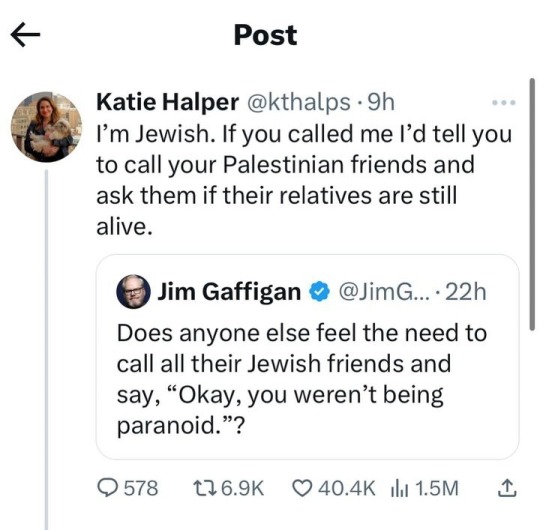

Important for people who are still stuck accusing people of antisemitism when they say genocide is actually not right.
#palestine#gaza#israel#important#current events#ethnic cleansing#free palestine#free gaza#gaza strip#gaza under attack#gaza under genocide#israel apartheid#israel is a terrorist state#jews#jewish people#jewish#jumblr#usa#america
38K notes
·
View notes
Text
In the final paragraphs of his obituary for Meir Kahane, Hazony qualified his adoration by clarifying that he never adopted Kahane’s political views or violent tactics. Yet this is arguably a distinction without much difference: If you regard Jews as the only group with the (divine) right to dwell in Israel/Palestine, and believe that colonizing the West Bank is the natural expression of your Jewishness, sooner or later you will come back to the “solutions” Kahane offered more than 40 years ago. Persistent violence by both state and state-adjacent actors in the name of upholding national integrity—along the lines of settler pogroms in the West Bank or anti-Muslim attacks in India—will be folded into the architecture of a legal framework built upon the right to discriminate." The real danger of National Conservatism is that there are enormous portions of the population that will not feel the sting of such measures at all. EBF’s UK chairman James Orr referenced this big-tent attitude in his opening remarks at the London conference, noting that National Conservatism has a “place of honor” in its coalition for many types of people—from “liberals appalled at the carnage of liberalism” to socialists “critical of the fact that the left has abandoned the working class” and the “gender critical feminist who has no space in the new left.” Of course, there are many people who fall outside the tent, and whose absolute otherness is decried by those within as an existential threat. For those of us who exist as majority populations, who are straight and cisgender, whose everyday preoccupations track rising childcare costs more than debates within constitutionalism, National Conservatism has much to offer, albeit at horrific cost to Others of various kinds. The real danger, perhaps best exemplified by Jewish Israelis going about their business with nary a thought of the occupation, is that many people will find that’s a deal they can live with."
-
For Yoram Hazony, the founder of the National Conservative movement, Israel is an illiberal model for the international nationalist brigade.
Suzanne Schneider
0 notes
Text
Not naming names nor am I Jewish, I am however an ally to the Jewish people. You know better, check yourselves.

#meera.txt#psa#antisemitism#current events#jumblr#safe to reblog#safe to rb#jewish history#history#stop jewish hate#free palestine#israel#Palestine#gaza#free palestine from hamas
1K notes
·
View notes
Text
I’m was watching a video about a Jewish custom, and the entire comment section was like this
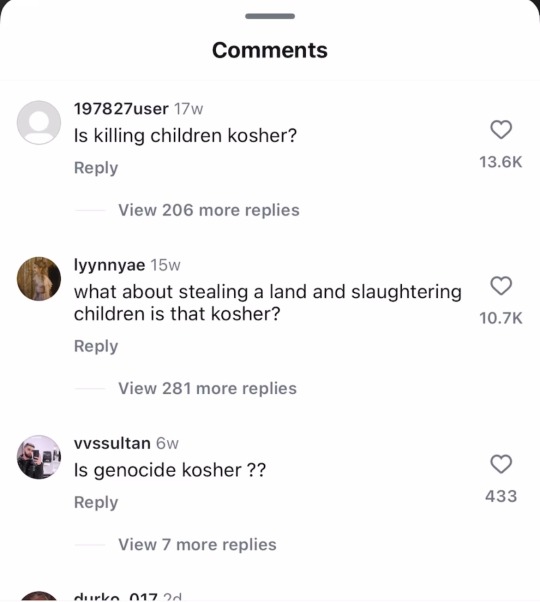
It’s about anti Zionism my ass.
This is the case whenever a post has Hebrew/ Jewish symbols/ etc. it’s obviously not about Israel.
#israel#jewish#israeli#jewblr#israel palestine conflict#gaza strip#ישראל#טאמבלר ישראלי#hamas is isis#middle east#jumblr#Gaza#gaza strikes#עברית#current events#human rights#middle eastern history#antisemitism#ישראלי#news on gaza#iran#yemen#free gaza#gaza genocide#believe jewish women
2K notes
·
View notes